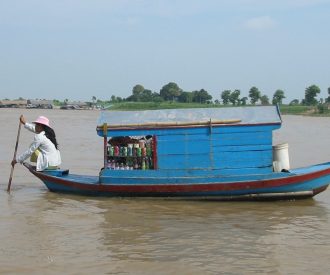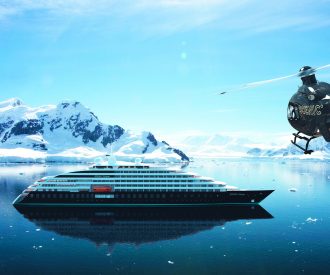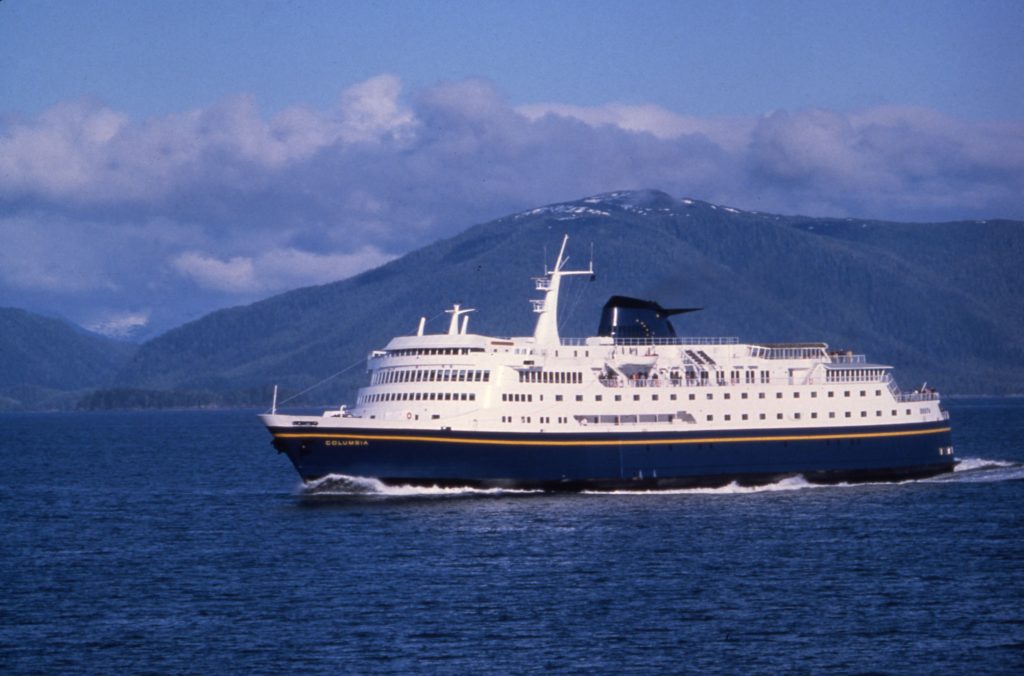
Alaska Marine Highway’s flagship Columbia. * Photo: John Rain
The Alaska Marine Highway is in a category by itself in more ways than one.
Snapshot: The Alaska Marine Highway (AMH) is the only long-distance ferry service in the United States that offers sleeping cabins and multiple day journeys. There are a variety of routes and, therefore, different itineraries to develop. Unlike a straight cruise, you can stop over for a day or two or longer, and the main routes operate year-round, though the frequency will decrease in the off-season. Why the 24/7 over 365 days? Well, the capital city Juneau has no highway connections to the outside world nor does Ketchikan, Wrangell, Petersburg or Sitka plus a bunch of small towns. It’s ferry or fly.
When Alaska became a state in 1959, transport by land or sea to most of the Panhandle cities did not exist as the former Alaska Steamship Line had recently ceased operations. One short-sea route did operate, a small day ferry between Skagway and Haines to Juneau. Then in 1963, the state inaugurated regular ferry services with three brand-new vessels — Malaspina, Matanuska, and Taku — that offered cabins, a restaurant, cafeteria, bar lounge, heated solarium and lots of deck space. Road and rail access from the Lower 48 connected to a weekly ferry from Seattle (now Bellingham, Washington) to the Panhandle; by road and rail from Prince Rupert, B.C. located just south of the Alaska state border; by road from Haines if coming from Anchorage or Fairbanks; and eventually from Skagway when a road opened to Whitehorse. The Yukon Territory capital straddles the 1,523-mile Alaska Highway providing road connections through Canada to and from the U.S. Lower 48. Two of the three original ships are still running (not Taku) along with others, and new ones are under construction. All the state ferries are named after Alaska glaciers and the state flag — the Big Dipper pointing to the North Star on a deep blue background — provides the ship’s funnel marking.
For a first-hand account of cruising on the AMH, have a gander at Ted’s wonderful article, “Finding My Route to Alaska.”
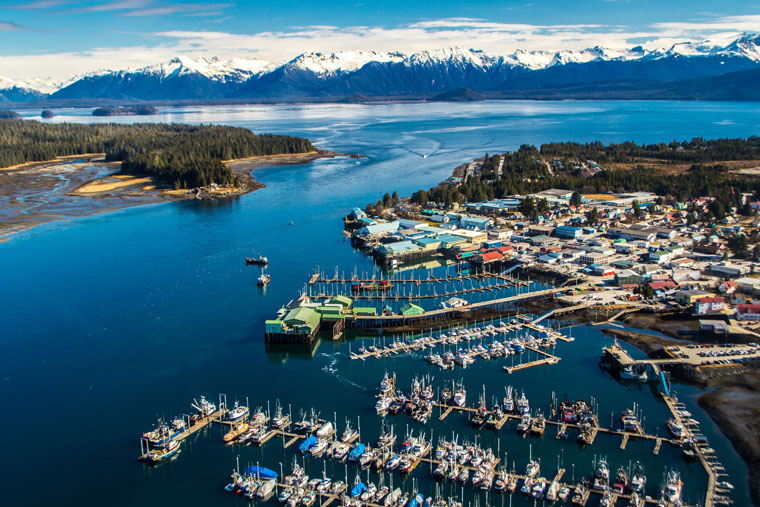
Petersburg’s thriving fishing and yachting port. * Wild Iris Photography
Ship, Year Delivered & Passengers: Columbia (built 1973 & 298 cabin berths), Kennicott (b. 1998 & 306 berths), Malaspina (b. 1963 & 233 berths), Matanuska (b. 1963 & 222 berths) and Tustumena (b. 1964 & 59 berths). Deck passengers are not included in these figures.
Passenger Decks: Columbia & Kennicott have four passenger decks and the others three. All vessels with cabin accommodations have an elevator.
Passenger Profile: Alaskans traveling to and from the Lower 48, Americans, Canadians and foreign tourists, especially in the summer months. All ages in all categories.
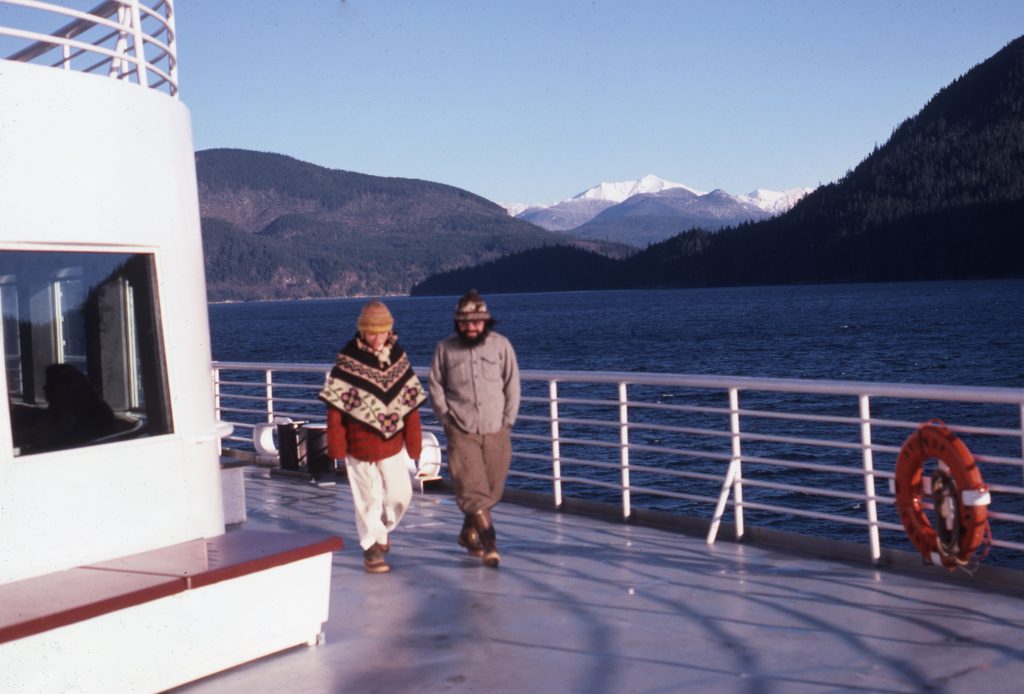
Taking that constitutional. * Photo: Ted Scull
Price: $ to $$ – The lower end of the fare schedule would include transportation as a deck passenger, then extras such as cabin berths, meals, vehicle, bicycle, kayak, and a pet add to the total cost.
Itineraries: The length of the ferry routes stretch from Bellingham, Washington and go north through the Inside Passage, then arc west into the Gulf of Alaska and southwest along the Aleutian Island chain to Dutch Harbor, adding up to some 3,500 miles. Basically, the individual routes are the Inside Passage (Washington State via Panhandle cities to Skagway); Southcentral Alaska; and Southwest, Kenai Peninsula and Aleutian Islands. The most popular trip is from Washington State (a port north of Seattle) to the Panhandle and return (7 nights). Others involve stopping over. For instance, use the weekly service in either or both directions between Bellingham and Ketchikan, the latter located at the south end of the panhandle region. From there to Skagway in the north, you have frequent services between all the main towns, from daily to 3, 4 ,5 times a week making stopovers easy to arrange. Many interport passages are a short few hours in the daytime and do not require a cabin.
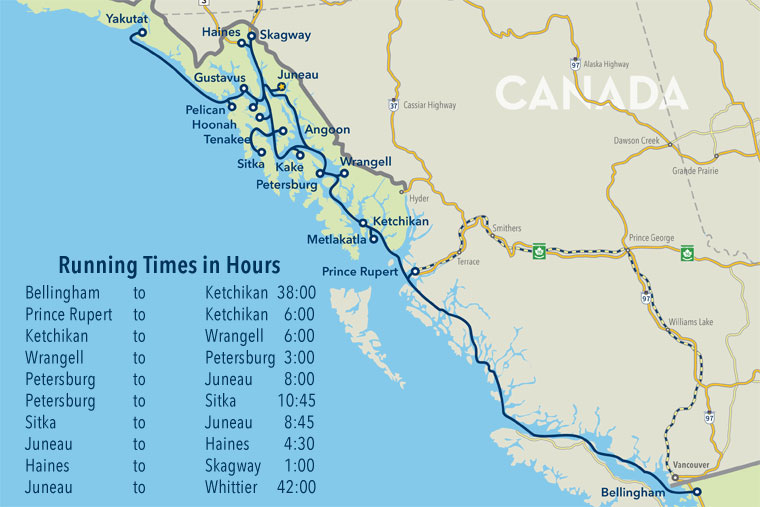
The route from Washington north to the Alaska Panhandle & Skagway. * Photo: Alaska Marine Highway
- The mainline route (weekly on a Friday evening) begins at Bellingham, Washington, some 90 miles (150 km) north of Seattle, with the first stop in Alaska at Ketchikan (38 hours), then Wrangell, Petersburg, Juneau, Haines, Skagway, Haines, Sitka and return via Juneau, Petersburg, Wrangell and Bellingham, WA (arriving Friday morning).
- Another more frequent service has its terminal at Prince Rupert, B.C. and calls at Panhandle ports in both directions.
- Day ferries service other small Panhandle towns, also all isolated from the highway system.
- A regular but infrequent route operates from Juneau and Panhandle ports, crossing the Gulf of Alaska (call at Yakutat) to Whittier (42 hours).
- Southcentral ferries serve towns such as Cordova, Valdez, Whittier, Homer; Southwest ferries operate from Kodiak on Kodiak Archipelago to ports along the Alaska Peninsula and the Aleutian Island chain to Dutch Harbor. This last route, using the well-strengthened Tustumena encounters some of the roughest weather in the world; some adventurers actually sail the route hoping to experience extreme weather conditions.
Included features: Everything is a la carte except the basic fare. Senior fares are available. Cabins, food and drinks extra. Tipping is minimal or non-existent.
Why Go? Majestic mountains, deep fjords, glaciers, seascapes, forests, wildlife (birds, animals, whales), history (Russian occupation especially at Sitka and the gold rush), Native Alaskan culture, kayaking, hiking, fishing, totems, and Juneau (Alaska’s capital with an excellent state museum).
When to Go? Mainline routes operate year-round, and every season has its positives. Ferries are most crowded and packed in the summer months between certain city pairs. Spring and fall will be chilly especially around water, and in winter months the Panhandle will be as cold as the coast of Maine and much colder in the interior areas, such Anchorage and Fairbanks. Winter will also see very little daylight, more in the Panhandle than in the interior parts of the state.
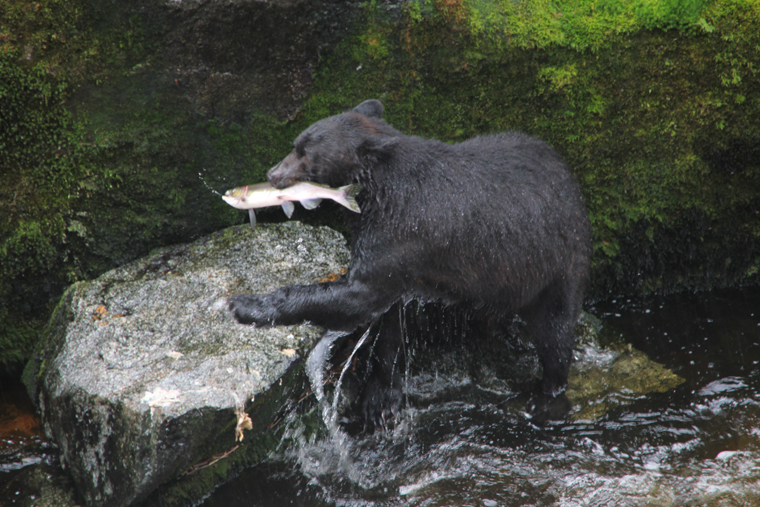
Anan Creek, Wrangell. * Photo: Wrangell C&V Bureau
Cabins: If traveling in the main season, book as far ahead as possible (months ahead) as cabins sell out fast (some cabins have windows and some do not). Vessels with cabins are Columbia (45 4-berth, 56 2-berth, 3 wheelchair accessible), Kennicott (48 4-berth, 58 2-berth*, 3 wheelchair accessible), Malaspina 45 4-berth, 26 2-berth, 1 wheelchair accessible), Matanuska (21 3-berth, 79 2-berth, 1 wheelchair accessible), and Tustumena (6 4-berth, 17 2-berth, 1 wheelchair accessible). *Kennecott has some 2-berth cabins without wash basin or linens supplied.
Public Rooms: The Columbia has two forward observation lounges. All ships (except Tustumena) have a cafeteria for all meals, observation lounge, solarium, a movie lounge and a children’s playroom.
Dining: The Columbia has both a table-service restaurant as well as a cafeteria and Tustumena has a dining room only. The rest of the fleet operates with a cafeteria. The food preparation uses high quality ingredients, and the selection is varied.
Activities & Entertainment: The staff may present some wildlife information and on-deck talks in the manner that the National Parks guides used to in the summer time. Budget cuts eliminated the latter, along with separate bar service, and souvenir shop.
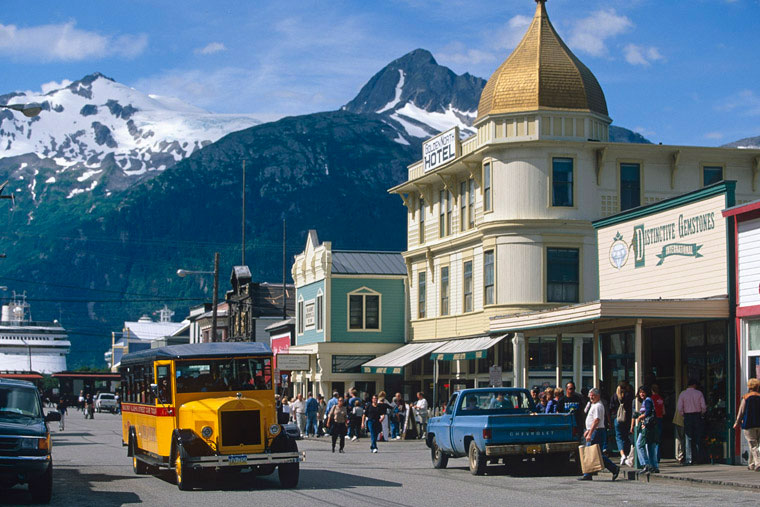
Skagway, the most northerly stop on the Inside Passage and a place full of activities. * Photo: Skagway C&V Bureau
Special Notes: If traveling between late May and early September, be sure to book cabins and vehicle space as far in advance as you are able. The main services from Washington State and throughout the Panhandle are protected from Pacific Ocean wave action, the exception being two short stretches along the B.C. coast, the first of two hours and then just 30 minutes.
Along the Same Lines: While there is nothing else like the AMH in North or South America, the Hurtigruten along the Norwegian Coast serves much the same basic functions — port to port passengers, vehicles and cargo. However, their ships are nearly all larger, newer and also geared heavily to cruise-type passengers and offer more cruise type amenities than on AMH.
Contact: Alaska Marine Highway, P.O. Box 112505, 6858 Glacier Highway, Juneau, Alaska 99811-2505; 800-642-0066; http://www.dot.state.ak.us/amhs/.
— TWS
![]()
Posted In:




